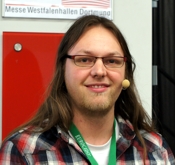The title of the official Eurocido seminar programme held on the first day of the event on 15 February was ‘The future of pest control is green’ . As well as the opening address which looked at the USA’s approach to green – see report here – the programme included an in-depth technical session on the safety of biocides. This comprised two papers on risk mitigation and the registration of rodenticides.
The first was given by Stefan Gartiser from Hydrotox GmbH, a German contract research and regulatory consultancy. After a detailed technical explanation of how risk is assessed, he pointed out the difference between risk classification and risk mitigation measures. The first is to do with ‘product design’ and these risks are taken into account during the approval process. This results in a risk classification for the product.
Risk mitigation measures, such as ‘for professional use only’ and ‘field of use’ restrictions as well as specific label instructions, come after the classification is made and are about how products are used. He explained how different countries in Europe have different risk mitigation measures so there is no harmonisation and no agreement between the countries in practice and he concluded that risk minimisation measures are only as good as the level of compliance among users.
Stefan also touched on the definition of ‘the sustainable use of biocides’. He said that this is often very broad ‘to safeguard the needs of the current generation without harming future generations’ and that three pillars of sustainable development are frequently quoted. These are the environment pillar, the social pillar and the economic pillar. He suggested that the most important pillar is the environment because irreversible damage to the environment will preclude social and economic development.
In the second presentation Dr Beatrice Schwartz-Schultz from Umweltbundesamt – the German Federal Environment Agency outlined the concepts of PEC (Predicted Environmental Concentration) and PNEC (Predicted No Effect Level). The ratio between PEC and PNEC is used as an indicator of risk. If the PEC is greater than the PNEC (i.e. ratio > 1 ), then there is a risk of adverse effects on the environment. Under the Biocidal Products Directive no substance with a ratio above 1 should be added to the Annex 1 approval listing. “All second generation anticoagulant rodenticides have failed this test and have a PEC to PNEC ratio greater than 1,” she said. “They have only been put onto Annex 1 under a special dispensation because of resistance fears and the fact that there are currently no alternatives. This is why they have been given a shorter five year listing and is the reason why risk minimisation measures must be taken when using the products.”
It is also the reasoning behind the German authority’s recent move, which will shortly see rodenticide products being reclassified as ‘for professional use only’. For UK PCOs this is an interesting development as many have expressed concerns at the rise in the DIY market. Will similar restrictions be brought in in the UK? In Germany professional use is clearly defined with PCOs having to compete three years of training and hold a certificate to work in pest control. That definition is not so clear cut in the UK and could make such a reclassification more difficult. Only time will tell!
|
The green theme continued into day two of the event when the seminar programme was provided by CEPA. Among the speakers was Bruce Schoelitsz, an entomologist from KAD (Kenniscentrum Dierplagen) the centre for pest control knowledge in The Netherlands. His subject was Integrated Pest Management (IPM) in Urban Pest Management. He outlined an interesting model that he has developed to provide a structure to the thought processes required to implement IPM. In summary this model takes into account the ecology of the pest, including birth and death rates and the impact of migration into and out of the area in which the pests are living. To this he has added the concept of the carrying capacity of the environment. This carrying capacity is the ceiling on the pest population size. |
|
|
Depending on the circumstances of the pest infestation, somewhere between zero and the carrying capacity will be the unacceptable level of pests. This is where the pests start to cause economic damage or pose a health risk. The goal of the pest controller is to reduce the level of the pest to below this unacceptable level.
There are various ways in which this can be done. A simple pesticide-based solution will kill the pests present but will not solve the problem over the longer term. To do that will require a more integrated approach. The first step must be to reduce the carrying capacity as much as possible by, for example, removing food, water and harbourage. The next step is to stop migration by preventing pests getting into the area. This means searching for and blocking up holes and the like. Together these two activities may reduce the population to below the unacceptable level and do the job. If they do not then the third step is to move on to a chemical control.
This is IPM.


